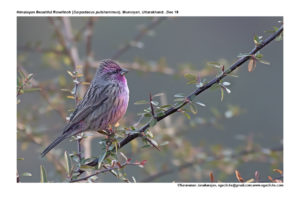
Beautiful Rosefinch Carpodacus pulcherrimus
Etymology :
- Carpodacus : Greek word karpos- fruit; dakos –biter { Fruit eater/biter}
- Pulcherrimus : Latin word for Very beautiful
Vernacular Names: Tibetan: Do-di
Distribution in India: Resident of Central Himalayas from North India (Himachal Pradesh) Eastwards
Description: Size of 13–15 cm; wt. of 17·5-21 g. It is a medium-sized, slender Rosefinch with long tail that is slightly forked. The male of nominate race has lowermost forehead to lores and chin as deep crimson, pale lilac-pink supercilium broadening behind eye and fading at rear of ear-coverts. The upper forehead to crown and nape are streaked broadly dark brown or blackish and pale pinkish-grey or greyish-brown. The upperparts are paler grey, streaked broadly darker with long parallel streaks on sides of mantle and back, rump is pale pink, uppertail-coverts are brown or dark brown, edged pale rose-pink. The tail is dark brown, feathers are edged paler or warm brown. The upperwing is dark brown, median and greater coverts are edged warmer brown and tipped pale pink, flight-feathers are edged paler brown, more buff-brown on secondaries and tertials, latter tipped paler whitish-buff. The cheek and ear-coverts to breast are deep pink, streaked finely darker and broadly tipped silvery pink on ear-coverts. It is slightly paler pink on throat. The side of breast and flanks finely streaked darker pink; belly to undertail-coverts white or pale pinkish. The iris is dark brown or black; bill is dark brown above and paler below. The legs are pale flesh-brown. The female lacks pink in plumage; has forehead to crown and upperparts as warm buff-brown or sometimes light buffy-grey, streaked heavily blackish-brown more thinly streaked on forehead to crown. The rump and uppertail-coverts are unstreaked; face is pale brown to greyish-brown, finely streaked darker, short pale buff-brown supercilium over or behind eye ends abruptly over ear-coverts. The tail is as on male; upperwing-coverts tipped pale buff or yellowish-buff, flight-feathers and tertials are broadly edged paler brown, latter broadly tipped pale buffish. The chin and throat are whitish, becoming buffish-brown and heavily streaked dark brown on underparts, paler or whiter on lower belly; bare parts much as for male. The juvenile, also first-winter and first-summer males, are like adult female; adult-like male plumage acquired in late summer of second year, with upperparts tinged pinkish, bright pink rump, and pinkish suffusion on throat.
Habitat: It is found in montane and submontane forest edges, rhododendrons, oak, sea-buckthorn, juniper and Caragana scrub along or above tree-line, in sparsely vegetated slopes, valleys and steep hillsides. It breeds from 3600 to 4700 m. In non-breeding season found in similar habitat at lower levels, also bushes and scrub in forest clearings, edges of cultivation and around human settlements, occasionally in suburban town parks; comes down to 2700m.
Food Habits: It eats small seeds and buds. It forages on the ground and in low vegetation around bushes and in shrubs. It often spends long periods perched motionless in bush; when alarmed raises short crest, and when disturbed by predator freezes until danger passed. It is found in pairs and small groups.
Breeding habits: They breed in Jun–Sept. The nest is a cup mostly of grass, plant fibres, roots, bark strips and animal hair, placed low down in shrub. They lay a clutch of 4–5 eggs. The incubation is done by female alone.